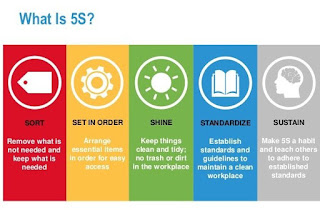5S is a system and way of organizing and managing workspaces to improve efficiency by eliminating waste, improving flow and reducing process. 5S systems are common in manufacturing, warehouses, offices and hospitals but 5S principles can be applied to any workplace.
Pioneered by Toyota Motor Company, the 5S method applies standard housekeeping practices in the workplace through the five principles of Sort (seiri), Set in order (seiton), Shine (seiso), Standardize (seiketsu), and Sustain (shitsuke).
5S Principles
A cluttered and untidy workplace can lead to low productivity, worker dissatisfaction and re-occurring accidents. The 5S Principles can help identify and eliminate wastage to achieve a more organized and safer working environment.
1. SORT (SEIRI)
The first step in 5S “Sort” aims to figure out which materials or items need to be removed by sorting.
· Gather your team and ask if there are defective tools and equipment, outdated items, and other non-essential materials on site.
· Determine how frequent you use workplace items or tools (daily, weekly, monthly, or never) and apply the red tagging technique when unsure in the removal of items. Red tagged materials must undergo verification before taking necessary action.
· Temporarily store items that are difficult to classify.
2. SET IN ORDER (SEITON)
The goal of “Set in Order” is to create good visual management. Consider these three important points: (1) what items to position, (2) the quantity, and (3) where to place items accordingly.
· Always allocate and store items in accessible and navigable spots.
· Group tools and items based on use and function and label or color-code them so they are easier to find and identify.
· Heavy loads and materials should be placed at an appropriate height where the worker can easily pick or carry them without straining.
3. SHINE (SEISO)
Housekeeping and cleaning are essential ways to not only remove dust, dirt, and other waste, but also to promote safety in the workplace. Activities and items that cause dirt, contamination, and filth are traced and actioned. With proper application of the Shine principle, work processes can be improved or corrected.
· Establish cleaning routines, targets and responsibilities.
· Clean the work area after the shift ends. A five-minute clean up is enough.
· Ensure that tools and equipment, including storage areas, are clean and ready for use at all times.
· Check for oil spills, excess, leaks, equipment damages, worn out cables, burnt out bulbs, etc.
· Install adequate lighting to easily recognize dirt and dust.
Applying the concept of “Shine” can help workers experience a clean and safe work-space, allowing them to focus more on performing their tasks well.
4. STANDARDIZE (SEIKETSU)
When the first three S’s are established, best practices should be standardized by means of creating the workplace norm or company culture that every worker must conform with.
· Provide visual reminders or photos on walls as reference for proper and improper workplace set up.
· Assign roles and set expectations of workers’ responsibility to maintain the culture of cleanliness.
· Use digital checklists to conduct routine audits and regular maintenance.
5. SUSTAIN (SHITSUKE)
Sustaining good practices and improvements is never easy. The final step of 5S will help workers contribute to maintaining a healthy and safe working environment. The Sustain concept will require self-discipline and compliance to new approaches. Here are four key points to keep in mind:
· Communication - Have all new procedures been rolled out to all workers? Are workers aware of their responsibility to report ineffective processes?
· Education - Are adequate trainings conducted for workers?
· Rewards and recognition - Are all workers’ effort recognized through rewards?
· Time - How often do you audit housekeeping practices? Scheduled daily, weekly, or monthly? Do you allot enough time to check if new processes are indeed effective?
5S + Safety = 6S
Many businesses and organizations have included an additional step to the 5S principle - “Safety.” The goal of the sixth step is to identify workplace hazards as you go while implementing the five housekeeping steps. By keeping Safety in mind along with 5S, you not only focus on making your workplace clean and tidy but also ensure that it is safe at all times.
The 5S method is not a difficult concept to understand and when applied successfully and consistently, can lead to improved employee productivity, safety, and quality of work.
















Comments
Post a Comment